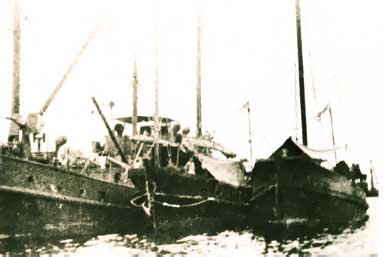
Above: Mother Snake with charges Tiger Snake and River Snake Alongside.
HMA Ships Kuru, Tiger Snake, River Snake, Black Snake, Sea Snake, Grass Snake, Diamond Snake, Mother Snake, Taipan, Krait, Kuru, Alatna, Karina, Nyanie, Misima, Motor Work Boats (AM) 1830, 1629, 1983, 1985, 2003, 2004.
The activities of “Z” special Forces and the Services Reconnaissance Department (SRD) have become as much part of Australia’s military history as Gallipoli and Tobruk. “Z” special Force were Australian Army Commandos; SRD was a grab-bag of boats of all shapes and sizes crewed by the RAN, and it was their task to assist “Z” Special Forces with transport, reconnaissance, supply, insertion and so on. Operations saw various parts of the force involved in raids into Singapore Harbour, the Celebes, Timor and Borneo, the pace of operations increasing steadily towards the end of the war.
In the hard times of 1942 and 1943, when the Australians, British and Americans were struggling to contain Japanese expansion, some vessels became little legends in their own right. Kuru, a minute motor-boat of just 55 tons, made a hero of herself on the “Timor Ferry Service” in early 1942; along with the auxilliary patrol vessel Vigilant, she ferried refugees, commandos, stores and equipment between Fremantle and small, dark bays on the Timor coast – a round trip of more than 6,000 kilometres. But perhaps the best known was Krait, originally the Japanese Kofoku Maru, a 70-foot wooden motor fishing vessel of 1920 vintage. She was seized at Singapore and sailed away before the place fell to the Japanese on 15th February 1942. An excellent type of vessel for raiding, she was taken into service and carried out many daring intrusions into enemy territory. The most famous was Operation “Jaywick”, the successful insertion of canoe-borne Commandos into Singapore Harbour (26th September 1943).
Alatna, Karina, Nyanie and Misima were “AM”s – army launches transferred to Naval service, each of 62 feet and capable of 20 knots, bearing a couple of machine guns by way of armament and with considerable capacity for shifting large amounts of cargo. They first came into service at the beginning of 1944. They were officially tenders, but in practice were used as fast supply boats – “fast supply” meaning running guns and stores across five thousand kilometres of open ocean into enemy-held areas and delivering them to the commandos operating behind enemy lines.
By the end of 1944, three vessels were being used as depot ships by these raiders. Taipan was a junk, captured and converted; Anaconda and Mother Snake were big “mother ships” for the raiders, of 550 tons displacement, 125 feet overall, with a large crew of 14 to 19. Anaconda carried a single 20 mm Oerlikon gun, while Mother Snake was a floating anti-aircraft battery by comparison, sporting a 40 mm Bofors gun and two Oerlikons.
The “Snake” boats came early in 1945, and in their way are a clear indication of the resources becoming available, and of the heights to which Australian Naval organisation was ascending. The “Snakes” were purpose-designed commando-carriers – trawlers of 66 feet and 80 tons, equipped with sail as well as motors, mounting at most an Oerlikon and a few machine guns, usually concealed. They looked very much like Malay fishing boats or Chinese junks – a deliberate design feature. They also carried one very special piece of equipment, the “S” phone. This invention of the British SOE (Special Operations Executive) was a short-range radio set which sent its signal down a narrow directional beam. Since it could only be received by someone the transmitter was pointing at, it was almost undetectable to conventional listening apparatus. It was thus very useful in smuggling spies across beaches. With the end of the war came the end of a need for Commando insertions – none of these boats had been lost in service, and all were turned over to civilian use, or in the case of the ex-army boats, returned by the Navy to their original owners. Sadly, Alatna was sunk in a collision within six months of the war ending.